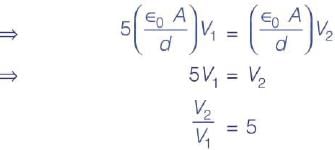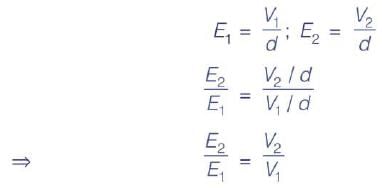Electrical Engineering (EE) Exam > Electrical Engineering (EE) Questions > Consider a large parallel plate capacitor. Th...
Start Learning for Free
Consider a large parallel plate capacitor. The gap ‘cf between the two plates is filled entirely with a dielectric slab of relative permittivity 5. The plates are initially charged to a potential difference of 1/volts and then disconnected from the source, If the dielectric slab is pulled out completely, then the ratio of the new electric field E2 in the gap to the original electric field E1 i s ________ .
Correct answer is '(5)'. Can you explain this answer?
Most Upvoted Answer
Consider a large parallel plate capacitor. The gap ‘cf between t...
Between the plates is filled with a dielectric material of relative permittivity εr. The area of each plate is A, and the separation between the plates is d. The capacitance of the capacitor is given by the formula:
C = (ε0 * εr * A) / d
where C is the capacitance, ε0 is the vacuum permittivity (8.85 x 10^-12 F/m), εr is the relative permittivity, A is the area of each plate, and d is the separation between the plates.
The capacitance of a parallel plate capacitor increases when the relative permittivity of the dielectric material increases. This is because the relative permittivity is a measure of how much the dielectric material can store electric charge per unit volume compared to vacuum. A higher relative permittivity means that the dielectric material can store more charge, leading to a higher capacitance.
Similarly, the capacitance of a parallel plate capacitor increases with an increase in the area of each plate. This is because a larger plate area provides more surface area for charge to accumulate, resulting in a higher capacitance.
On the other hand, the capacitance of a parallel plate capacitor decreases with an increase in the separation between the plates. This is because a larger separation reduces the electric field between the plates, reducing the amount of charge that can be stored, resulting in a lower capacitance.
In summary, the capacitance of a large parallel plate capacitor is directly proportional to the relative permittivity and the area of each plate, and inversely proportional to the separation between the plates.
C = (ε0 * εr * A) / d
where C is the capacitance, ε0 is the vacuum permittivity (8.85 x 10^-12 F/m), εr is the relative permittivity, A is the area of each plate, and d is the separation between the plates.
The capacitance of a parallel plate capacitor increases when the relative permittivity of the dielectric material increases. This is because the relative permittivity is a measure of how much the dielectric material can store electric charge per unit volume compared to vacuum. A higher relative permittivity means that the dielectric material can store more charge, leading to a higher capacitance.
Similarly, the capacitance of a parallel plate capacitor increases with an increase in the area of each plate. This is because a larger plate area provides more surface area for charge to accumulate, resulting in a higher capacitance.
On the other hand, the capacitance of a parallel plate capacitor decreases with an increase in the separation between the plates. This is because a larger separation reduces the electric field between the plates, reducing the amount of charge that can be stored, resulting in a lower capacitance.
In summary, the capacitance of a large parallel plate capacitor is directly proportional to the relative permittivity and the area of each plate, and inversely proportional to the separation between the plates.
Free Test
FREE
| Start Free Test |
Community Answer
Consider a large parallel plate capacitor. The gap ‘cf between t...

If voltage source is removed then in both cases charge Q is constant.
Case-1: (Q1, = Q; V1 = V)
Q1 = C1 V1
 ...(i)
...(i)Case-2: (Q2 = Q; V2)
Q2 = C2V2
 ...(ii)
...(ii)Equation (i) is equal to equation (ii)
 ...(iii)
...(iii) ...(iv)
...(iv)Put equation (iii) in equation (iv),


|
Explore Courses for Electrical Engineering (EE) exam
|

|
Similar Electrical Engineering (EE) Doubts
Question Description
Consider a large parallel plate capacitor. The gap ‘cf between the two plates is filled entirely with a dielectric slab of relative permittivity 5. The plates are initially charged to a potential difference of 1/volts and then disconnected from the source, If the dielectric slab is pulled out completely, then the ratio of the new electric field E2 in the gap to the original electric field E1 i s ________ .Correct answer is '(5)'. Can you explain this answer? for Electrical Engineering (EE) 2025 is part of Electrical Engineering (EE) preparation. The Question and answers have been prepared according to the Electrical Engineering (EE) exam syllabus. Information about Consider a large parallel plate capacitor. The gap ‘cf between the two plates is filled entirely with a dielectric slab of relative permittivity 5. The plates are initially charged to a potential difference of 1/volts and then disconnected from the source, If the dielectric slab is pulled out completely, then the ratio of the new electric field E2 in the gap to the original electric field E1 i s ________ .Correct answer is '(5)'. Can you explain this answer? covers all topics & solutions for Electrical Engineering (EE) 2025 Exam. Find important definitions, questions, meanings, examples, exercises and tests below for Consider a large parallel plate capacitor. The gap ‘cf between the two plates is filled entirely with a dielectric slab of relative permittivity 5. The plates are initially charged to a potential difference of 1/volts and then disconnected from the source, If the dielectric slab is pulled out completely, then the ratio of the new electric field E2 in the gap to the original electric field E1 i s ________ .Correct answer is '(5)'. Can you explain this answer?.
Consider a large parallel plate capacitor. The gap ‘cf between the two plates is filled entirely with a dielectric slab of relative permittivity 5. The plates are initially charged to a potential difference of 1/volts and then disconnected from the source, If the dielectric slab is pulled out completely, then the ratio of the new electric field E2 in the gap to the original electric field E1 i s ________ .Correct answer is '(5)'. Can you explain this answer? for Electrical Engineering (EE) 2025 is part of Electrical Engineering (EE) preparation. The Question and answers have been prepared according to the Electrical Engineering (EE) exam syllabus. Information about Consider a large parallel plate capacitor. The gap ‘cf between the two plates is filled entirely with a dielectric slab of relative permittivity 5. The plates are initially charged to a potential difference of 1/volts and then disconnected from the source, If the dielectric slab is pulled out completely, then the ratio of the new electric field E2 in the gap to the original electric field E1 i s ________ .Correct answer is '(5)'. Can you explain this answer? covers all topics & solutions for Electrical Engineering (EE) 2025 Exam. Find important definitions, questions, meanings, examples, exercises and tests below for Consider a large parallel plate capacitor. The gap ‘cf between the two plates is filled entirely with a dielectric slab of relative permittivity 5. The plates are initially charged to a potential difference of 1/volts and then disconnected from the source, If the dielectric slab is pulled out completely, then the ratio of the new electric field E2 in the gap to the original electric field E1 i s ________ .Correct answer is '(5)'. Can you explain this answer?.
Solutions for Consider a large parallel plate capacitor. The gap ‘cf between the two plates is filled entirely with a dielectric slab of relative permittivity 5. The plates are initially charged to a potential difference of 1/volts and then disconnected from the source, If the dielectric slab is pulled out completely, then the ratio of the new electric field E2 in the gap to the original electric field E1 i s ________ .Correct answer is '(5)'. Can you explain this answer? in English & in Hindi are available as part of our courses for Electrical Engineering (EE).
Download more important topics, notes, lectures and mock test series for Electrical Engineering (EE) Exam by signing up for free.
Here you can find the meaning of Consider a large parallel plate capacitor. The gap ‘cf between the two plates is filled entirely with a dielectric slab of relative permittivity 5. The plates are initially charged to a potential difference of 1/volts and then disconnected from the source, If the dielectric slab is pulled out completely, then the ratio of the new electric field E2 in the gap to the original electric field E1 i s ________ .Correct answer is '(5)'. Can you explain this answer? defined & explained in the simplest way possible. Besides giving the explanation of
Consider a large parallel plate capacitor. The gap ‘cf between the two plates is filled entirely with a dielectric slab of relative permittivity 5. The plates are initially charged to a potential difference of 1/volts and then disconnected from the source, If the dielectric slab is pulled out completely, then the ratio of the new electric field E2 in the gap to the original electric field E1 i s ________ .Correct answer is '(5)'. Can you explain this answer?, a detailed solution for Consider a large parallel plate capacitor. The gap ‘cf between the two plates is filled entirely with a dielectric slab of relative permittivity 5. The plates are initially charged to a potential difference of 1/volts and then disconnected from the source, If the dielectric slab is pulled out completely, then the ratio of the new electric field E2 in the gap to the original electric field E1 i s ________ .Correct answer is '(5)'. Can you explain this answer? has been provided alongside types of Consider a large parallel plate capacitor. The gap ‘cf between the two plates is filled entirely with a dielectric slab of relative permittivity 5. The plates are initially charged to a potential difference of 1/volts and then disconnected from the source, If the dielectric slab is pulled out completely, then the ratio of the new electric field E2 in the gap to the original electric field E1 i s ________ .Correct answer is '(5)'. Can you explain this answer? theory, EduRev gives you an
ample number of questions to practice Consider a large parallel plate capacitor. The gap ‘cf between the two plates is filled entirely with a dielectric slab of relative permittivity 5. The plates are initially charged to a potential difference of 1/volts and then disconnected from the source, If the dielectric slab is pulled out completely, then the ratio of the new electric field E2 in the gap to the original electric field E1 i s ________ .Correct answer is '(5)'. Can you explain this answer? tests, examples and also practice Electrical Engineering (EE) tests.

|
Explore Courses for Electrical Engineering (EE) exam
|

|
Signup for Free!
Signup to see your scores go up within 7 days! Learn & Practice with 1000+ FREE Notes, Videos & Tests.


























